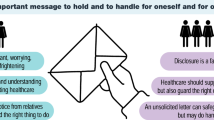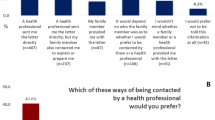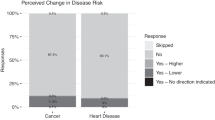Abstract
Genetic testing has revolutionized the identification of individuals at increased risk for various hereditary conditions, enabling early intervention and preventive measures. However, effective cascade counseling and testing depends on successful intra-familial communication. This mixed-method systematic review aimed to explore the general population’s perspectives and preferences regarding the communication of potential genetic risk information by healthcare professionals. This study adhered to the Preferred Reporting Items for Systematic Reviews and Meta-Analyses guidelines and was registered in the International Prospective Register of Systematic Reviews database (CRD42024532829). A comprehensive search of six databases yielded 17,292 records. After removing duplicates and screening for relevance, nine studies were included in the final analysis, conducted across diverse Western countries using both qualitative and quantitative designs. Results indicated a preference for healthcare-mediated communication, particularly through formal methods as letters, valued for their clarity and reliability. The role of family-mediated communication is nuanced, influenced by interpersonal relationship quality and the emotional burden of disclosing sensitive information. Ethical and legal considerations highlighted public support for overriding confidentiality in treatable conditions, while emphasizing respect for individual privacy and autonomy in untreatable conditions. This review underscores the importance of understanding public preferences to develop tailored communication strategies that balance professional involvement with respect for individual and familial dynamics. Healthcare professionals should be trained to provide empathetic, clear, and accurate information, considering the specific needs and contexts of at-risk individuals.
This is a preview of subscription content, access via your institution
Access options
Subscribe to this journal
Receive 12 print issues and online access
$259.00 per year
only $21.58 per issue
Buy this article
- Purchase on SpringerLink
- Instant access to full article PDF
Prices may be subject to local taxes which are calculated during checkout

Similar content being viewed by others
Data availability
Data on subsequent steps of literature search and selection are available upon request.
References
Alonso R, Perez de Isla L, Muñiz-Grijalvo O, Diaz-Diaz JL, Mata P. Familial hypercholesterolaemia diagnosis and management. Eur Cardiol Rev. 2018;13:14–20. https://doi.org/10.15420/ecr.2018:10:2.
Dheensa S, Fenwick A, Shkedi-Rafid S, Crawford G, Lucassen A. Health-care professionals’ responsibility to patients’ relatives in genetic medicine: a systematic review and synthesis of empirical research. Genet Med. 2016;18:290–301. https://doi.org/10.1038/gim.2015.72.
Menko FH, Ter Stege JA, van der Kolk LE, Jeanson KN, Schats W, Moha DA, et al. The uptake of presymptomatic genetic testing in hereditary breast-ovarian cancer and Lynch syndrome: a systematic review of the literature and implications for clinical practice. Fam Cancer. 2019;18:127–35. https://doi.org/10.1007/s10689-018-0089-z.
Parker M, Lucassen A. Using a genetic test result in the care of family members: how does the duty of confidentiality apply? Eur J Hum Genet. 2018;26:955–9. https://doi.org/10.1038/s41431-018-0138-y.
Frey MK, Ahsan MD, Bergeron H, Lin J, Li X, Fowlkes RK, et al. Cascade testing for hereditary cancer syndromes: should we move toward direct relative contact? a systematic review and meta-analysis. J Clin Oncol: J Am Soc Clin Oncol. 2022;40:4129–43. https://doi.org/10.1200/JCO.22.00303.
Trevisan L, Godino L, Battistuzzi L, Innella G, Luppi E, Buzzatti G, et al. Cascade testing in Italian Hereditary Breast Ovarian Cancer families: a missed opportunity for cancer prevention? Fam cancer. 2024;23:197–207. https://doi.org/10.1007/s10689-023-00349-w.
Daly MB, Montgomery S, Bingler R, Ruth K. Communicating genetic test results within the family: Is it lost in translation? A survey of relatives in the randomized six-step study. Fam Cancer. 2016;15:697–706. https://doi.org/10.1007/s10689-016-9889-1.
Srinivasan S, Won NY, Dotson WD, Wright ST, Roberts MC. Barriers and facilitators for cascade testing in genetic conditions: a systematic review. Eur J Hum Genet Eur J Hum Genet. 2020;28:1631–44. https://doi.org/10.1038/s41431-020-00725-5.
Austin J. Re‐conceptualizing risk in genetic counseling: implications for clinical practice. J Genet Couns. 2010;19:228–34. https://doi.org/10.1007/s10897-010-9279-z.
Shah L, Daack‐Hirsch S, Ersig A, Paik A, Ahmad F, Williams J. Family relationships associated with communication and testing for inherited cardiac conditions. West J Nurs Res. 2018;41:1576–601. https://doi.org/10.1177/0193945918817039.
Wiens M, Wilson B, Honeywell C, Etchegary H. A family genetic risk communication framework: guiding tool development in genetics health services. J Community Genet. 2013;4:233–42. https://doi.org/10.1007/s12687-012-0134-9.
Dheensa S, Fenwick A, Lucassen A. Is this knowledge mine and nobody else’s? I don’t feel that.’Patient views about consent, confidentiality and information-sharing in genetic medicine. J Med Ethics. 2016;42:174–9. https://doi.org/10.1136/medethics-2015-102781.
Dheensa S, Lucassen A, Fenwick A. Limitations and pitfalls of using family letters to communicate genetic risk: a qualitative study with patients and healthcare professionals. J Genet Couns. 2018;27:689–701. https://doi.org/10.1007/s10897-017-0164-x.
Varkey B. Principles of clinical ethics and their application to practice. Med Princ Pract: Int J Kuwait Univ Health Sci Cent. 2021;30:17–28. https://doi.org/10.1159/000509119.
Aktan-Collan K, Haukkala A, Pylvänäinen K, Järvinen HJ, Aaltonen LA, Peltomäki P, et al. Direct contact in inviting high-risk members of hereditary colon cancer families to genetic counselling and DNA testing. J Med Genet. 2007;44:732–8. https://doi.org/10.1136/jmg.2007.051581.
Henrikson NB, Blasi P, Figueroa Gray M, Tiffany BT, Scrol A, Ralston JD, et al. Patient and family preferences on health system-led direct contact for cascade screening. J Pers Med. 2021;11:538 https://doi.org/10.3390/jpm11060538.
Tiller J, Nowak K, Boughtwood T, Otlowski M. Privacy implications of contacting the at-risk relatives of patients with medically actionable genetic predisposition, with patient consent: a hypothetical Australian case study. BioTech. 2023;12:45.
Privacy Amendment (Enhancing Privacy Protection) Act No 24 (2024) (Australia) https://www.legislation.gov.au/C2004A03712/latest/text (accessed on 12 December 2024).
Henrikson, NB, Wagner, JK, Hampel, H, DeVore, C, Shridhar, N, Williams, JL, et al. (2020) What guidance does HIPAA offer to providers considering familial risk notification and cascade genetic testing? J Law Biosci 7. https://doi.org/10.1093/jlb/lsaa071.
Law No. 2021–1017 dated 2 August 2011 (art. 15) Code de la santé publique. L1131-1, JORF, 2021. https://www.legifrance.gouv.fr/codes/section_lc/LEGITEXT000006072665/LEGISCTA000006171009/#LEGISCTA000043895848 (accessed on 12 December 2024).
Lindberg, LJ, Wadt, KA, Therkildsen, C, & Petersen, HV (2024) National Experiences from 30 Years of Provider-Mediated Cascade Testing in Lynch Syndrome Families-The Danish Model. https://doi.org/10.3390/cancers16081577.
Menko FH, Aalfs CM, Henneman L, Stol Y, Wijdenes M, Otten E, et al. Informing family members of individuals with Lynch syndrome: a guideline for clinical geneticists. Fam Cancer. 2013;12:319–24. https://doi.org/10.1007/s10689-013-9636-9.
Marleen van den Heuvel L, Stemkens D, van Zelst-Stams WAG, Willeboordse F, Christiaans I. How to inform at-risk relatives? Attitudes of 1379 Dutch patients, relatives, and members of the general population. J Genet Couns. 2020;29:786–99. https://doi.org/10.1002/jgc4.1206.
Dutch Clinical Genetics Society (VKGN) (2019) Richtlijn Informeren van familieleden bij erfelijke aandoeningen. https://www.vkgn.org/files/5911/Richtlijn%20informeren%20van%20familieleden%20bij%20erfelijke%20aandoeningen.pdf (accessed on 10 September 2024).
Duttge G. The right to know and not to know: predictive genetic diagnosis and non-diagnosis. Recent results cancer Res Fortschr der Krebsforsch Prog dans les Rech sur le cancer. 2021;218:67–83. https://doi.org/10.1007/978-3-030-63749-1_6.
Pluye P, Hong QN. Combining the power of stories and the power of numbers: mixed methods research and mixed studies reviews. Annu Rev public health. 2014;35:29–45. https://doi.org/10.1146/annurev-publhealth-032013-182440.
Page MJ, McKenzie JE, Bossuyt PM, Boutron I, Hoffmann TC, Mulrow CD, et al. The PRISMA 2020 statement: An updated guideline for reporting systematic reviews. Int J Surg (Lond, Engl). 2021;88:105906 https://doi.org/10.1016/j.ijsu.2021.105906.
Cooke A, Smith D, Booth A. Beyond PICO: the SPIDER tool for qualitative evidence synthesis. Qualitat Health Res. 2012;22:1435–43. https://doi.org/10.1177/1049732312452938.
Godino L. How to structure Microsoft Excel documents for systematic reviews. Nurse Res. 2023;31:40–6. https://doi.org/10.7748/nr.2023.e1866.
Palese A, Mansutti I, Visintini E, Caruzzo D, Moreale R, Longhini J, et al. Framing the time while designing and conducting reviews: A Focused Mapping Review and Synthesis. J Clin Nurs. 2022;31:3523–34. https://doi.org/10.1111/jocn.16180.
Kmet LM, Lee RC, Cook LS. Standard quality assessment criteria for evaluating primary research papers from a variety of fields. HTA Initiat. 2004;13:1–28. https://doi.org/10.5858/arpa.2020-0217-sa.
Stern C, Lizarondo L, Carrier J, Godfrey C, Rieger K, Salmond S, et al. Methodological guidance for the conduct of mixed methods systematic reviews. JBI Evid Synth. 2020;18:2108–18. https://doi.org/10.11124/JBISRIR-D-19-00169.
Onwuegbuzie AJ. Effect sizes in qualitative research: a prolegomenon. Qual Quant. 2003;37:393–409. https://doi.org/10.1023/a:1027379223537.
Hawranek C, Hajdarevic S, Rosén A. A focus group study of perceptions of genetic risk disclosure in members of the public in Sweden: “I’ll Phone the Five Closest Ones, but What Happens to the Other Ten?”. J Pers Med. 2021;11:1191 https://doi.org/10.3390/jpm11111191.
Andersson A, Hawranek C, Öfverholm A, Ehrencrona H, Grill K, Hajdarevic S, et al. Public support for healthcare-mediated disclosure of hereditary cancer risk information: Results from a population-based survey in Sweden. Hered Cancer Clin Pr. 2020;15:18–30. https://doi.org/10.1186/s13053-020-00151-0.
Heaton TJ, Chico V. Attitudes towards the sharing of genetic information with at-risk relatives: results of a quantitative survey. Hum Genet. 2016;135:109–20. https://doi.org/10.1007/s00439-015-1612-z.
Maxwell SJ, Molster CM, Poke SJ, O’Leary P. Communicating familial hypercholesterolemia genetic information within families. Genet Test Mol Biomark. 2009;13:301–6. https://doi.org/10.1089/gtmb.2008.0138.
Petersen HV, Frederiksen BL, Lautrup CK, Lindberg LJ, Ladelund S, Nilbert M. Unsolicited information letters to increase awareness of Lynch syndrome and familial colorectal cancer: reactions and attitudes. Fam cancer. 2019;18:43–51. https://doi.org/10.1007/s10689-018-0083-5.
Phillips A, Dewitte I, Debruyne B, Vears DF, Borry P. Disclosure of genetic risk in the family: a survey of the Flemish general population. Eur J Med Genet. 2023;66:104800 https://doi.org/10.1016/j.ejmg.2023.104800.
Tiller JM, Stott A, Finlay K, Boughtwood T, Madelli EO, Horton A, et al. Direct notification by health professionals of relatives at-risk of genetic conditions (with patient consent): views of the Australian public. Eur J Hum Genet: Eur J Hum Genet. 2024;32:98–108. https://doi.org/10.1038/s41431-023-01395-9.
Wolff K, Brun W, Kvale G, Nordin K. Confidentiality versus duty to inform-an empirical study on attitudes towards the handling of genetic information. Am J Med Genet Part A. 2007;143A:142–8. https://doi.org/10.1002/ajmg.a.31467.
Van den Heuvel LM, Smets EMA, van Tintelen JP, Christiaans I. How to inform relatives at risk of hereditary diseases? A mixed-methods systematic review on patient attitudes. J Genet Couns. 2019;28:1042–58. https://doi.org/10.1002/jgc4.1143.
Zhu X, Smith RA, Parrott RL. Living with a rare health condition: the influence of a support community and public stigma on communication, stress, and available support. J Appl Commun Res. 2017;45:179–98. https://doi.org/10.1080/00909882.2017.1288292.
Leenen CH, Heijer MD, van der Meer C, Kuipers EJ, van Leerdam ME, Wagner A. Genetic testing for Lynch syndrome: family communication and motivation. Fam cancer. 2016;15:63–73. https://doi.org/10.1007/s10689-015-9842-8.
Marks D, Thorogood M, Neil SM, Humphries SE, Neil HA. Cascade screening for familial hypercholesterolaemia: implications of a pilot study for national screening programmes. J Med Screen. 2006;13:156–9. https://doi.org/10.1258/096914106778440617.
Suthers GK, Armstrong J, McCormack J, Trott D. Letting the family know: balancing ethics and effectiveness when notifying relatives about genetic testing for a familial disorder. J Med Genet. 2006;43:665–70. https://doi.org/10.1136/jmg.2005.039172.
Di Pietro ML, Zaçe D, Orfino A, Di Raimo FR, Poscia A, de Matteis E, et al. Intrafamilial communication of hereditary breast and ovarian cancer genetic information in Italian women: towards a personalised approach. Eur J Hum Genet. 2021;29:250–61. https://doi.org/10.1038/s41431-020-00723-7.
Weaver M. The double helix: applying an ethic of care to the duty to warn genetic relatives of genetic information. Bioethics. 2016;30:181–7. https://doi.org/10.1111/bioe.12176.
Mesters I, Ausems M, Eichhorn S, Vasen H. Informing one’s family about genetic testing for hereditary non-polyposis colorectal cancer (HNPCC): a retrospective exploratory study. Fam cancer. 2005;4:163–7. https://doi.org/10.1007/s10689-004-7992-1.
Stoffel EM, Ford B, Mercado RC, Punglia D, Kohlmann W, Conrad P, et al. Sharing genetic test results in Lynch syndrome: communication with close and distant relatives. Clin Gastroenterol Hepatol : Clin Pr J Am Gastroenterol Assoc. 2008;6:333–8. https://doi.org/10.1016/j.cgh.2007.12.014.
Hamilton R, Williams JK, Bowers BJ, Calzone K. Life trajectories, genetic testing, and risk reduction decisions in 18-39 year old women at risk for hereditary breast and ovarian cancer. J Genet Couns. 2009;18:147–59. https://doi.org/10.1007/s10897-008-9200-1.
Geer KP, Ropka ME, Cohn WF, Jones SM, Miesfeldt S. Factors influencing patients’ decisions to decline cancer genetic counseling services. J Genet Couns. 2001;10:25–40. https://doi.org/10.1023/a:1009451213035.
Godino L, Turchetti D, Jackson L, Hennessy C, Skirton H. Impact of presymptomatic genetic testing on young adults: a systematic review. Eur J Hum Genet. 2016;24:496–503. https://doi.org/10.1038/ejhg.2015.153.
Godino L, Jackson L, Turchetti D, Hennessy C, Skirton H. Decision making and experiences of young adults undergoing presymptomatic genetic testing for familial cancer: a longitudinal grounded theory study. Eur J Hum Genet. 2018;26:44–53. https://doi.org/10.1038/s41431-017-0030-1.
Godino L, Turchetti D, Jackson L, Hennessy C, Skirton H. Presymptomatic genetic testing for hereditary cancer in young adults: a survey of young adults and parents. Eur J Hum Genet. 2019;27:291–9. https://doi.org/10.1038/s41431-018-0262-8.
Godino L, Varesco L, Bruno W, Bruzzone C, Battistuzzi L, Franiuk M, et al. Preferences of Italian patients for return of secondary findings from clinical genome/exome sequencing. J Genet Couns. 2021;30:665–75. https://doi.org/10.1002/jgc4.1350.
Burke, K, Dawson, L, Hodgkinson, K, Wilson, BJ, Etchegary, H (2024). Exploring family communication preferences in hereditary breast and ovarian cancer and Lynch syndrome: a national Canadian survey. J Community Genet 1-14. https://doi.org/10.1007/s12687-024-00720-z.
Birkhäuer J, Gaab J, Kossowsky J, Hasler S, Krummenacher P, Werner C, et al. Trust in the health care professional and health outcome: a meta-analysis. PloS one. 2017;12:1–13. https://doi.org/10.1371/journal.pone.0170988.
LePoire E, Basu B, Walker L, Bowen DJ. What do people think about genetics? A systematic review. J Community Genet. 2019;10:171–87. https://doi.org/10.1007/s12687-018-0394-0.
Funding
Authors reported there is no funding associated with the work featured in this article.
Author information
Authors and Affiliations
Contributions
All the authors conceived the study. LG and DT designed the literature search plan. VG and LG conducted the literature search and screening. LG and DT contributed to the analytical planned bias assessment approach. LG drafted the manuscript. All authors revised the manuscript and approved the final version. PC and AP will supervise the study.
Corresponding author
Ethics declarations
Competing interests
The authors declare no competing interests.
Ethical approval
Approval by an Ethical Board was not required as this is a systematic review of published literature. However, it was registered in the “International Prospective Register of Systematic Review” (PROSPERO) in 2024 (CRD42024532829; Available from: https://www.crd.york.ac.uk/prospero/display_record.php?ID=CRD42024532829).
Additional information
Publisher’s note Springer Nature remains neutral with regard to jurisdictional claims in published maps and institutional affiliations.
Supplementary information
Rights and permissions
Springer Nature or its licensor (e.g. a society or other partner) holds exclusive rights to this article under a publishing agreement with the author(s) or other rightsholder(s); author self-archiving of the accepted manuscript version of this article is solely governed by the terms of such publishing agreement and applicable law.
About this article
Cite this article
Godino, L., Turchetti, D., Gentili, V. et al. Public perspectives on healthcare professional-directed communication of hereditary genetic risks: a mixed-method systematic review. Eur J Hum Genet (2025). https://doi.org/10.1038/s41431-025-01790-4
Received:
Revised:
Accepted:
Published:
DOI: https://doi.org/10.1038/s41431-025-01790-4
This article is cited by
-
Maximizing cascade genetic testing for disease prevention through direct notification of at-risk relatives
Nature Medicine (2025)
-
Developing a questionnaire to explore lay people’s preferences for communicating hereditary conditions within families: insights from a cognitive interview study
Journal of Community Genetics (2025)



